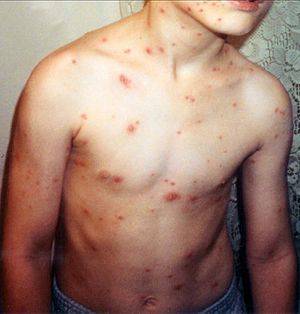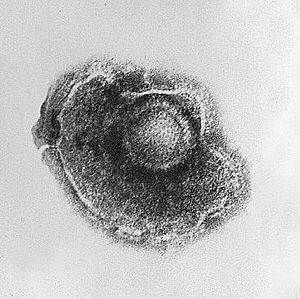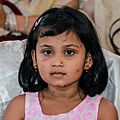Chickenpox facts for kids
Chickenpox, also known as varicella, is a very contagious illness. This means it spreads easily from person to person. It is caused by a virus called the varicella zoster virus (VZV). When you get chickenpox, you usually get a special skin rash. This rash forms small, itchy blisters that eventually dry up and scab over. The rash often starts on your chest, back, and face. Then, it spreads to other parts of your body.
Besides the rash, you might also have a fever, feel tired, or have headaches. These symptoms usually last for about five to seven days. Sometimes, serious problems can happen, like pneumonia (a lung infection) or swelling in the brain. Bacterial skin infections can also occur. Chickenpox is often more serious for adults than for children. Symptoms usually appear 10 to 21 days after you are exposed to the virus.
Chickenpox spreads easily through the air. When an infected person coughs or sneezes, tiny virus particles can spread. You can spread the virus starting one or two days before the rash appears. You remain contagious until all the blisters have formed scabs. You can also get chickenpox by touching the blisters directly.
Most people only get chickenpox once in their life. Even if the virus stays in your body, it usually does not cause symptoms again. Getting chickenpox during pregnancy can be dangerous for both the mother and the baby.
Chickenpox happens all over the world. In 2013, there were 140 million cases of chickenpox and herpes zoster worldwide. Before vaccines were common, the number of cases each year was similar to the number of babies born. Since the chickenpox vaccine became available, the number of infections in the United States has dropped by almost 90%.
Chickenpox is caused by a virus that belongs to the herpes family. People who have had chickenpox in the past can sometimes get a related illness later in life called shingles. Shingles is caused by the same virus, but it usually affects only one part of the body.
There is a vaccine that can protect you from chickenpox. This vaccine is usually given to children. If a child has not had chickenpox before puberty (around 9–13 years old), they might get the vaccine. To help with the itchiness of chickenpox, you can use special creams like e45.
The term "chicken pox" was first used in 1658. People have different ideas about why "chicken" is in the name. One idea is that it describes how mild the disease usually is.
What are the Signs and Symptoms of Chickenpox?
The first signs of chickenpox in teenagers and adults can include feeling sick to your stomach, not wanting to eat, muscle aches, and a headache. After these early signs, the typical rash or sores inside the mouth appear, along with a mild fever. These signal that you have chickenpox.
The rash starts as small red dots on your face, scalp, body, and upper arms and legs. Over the next 10–12 hours, these dots turn into small bumps, then into blisters, and finally, they form scabs.
The illness usually gets better on its own within a couple of weeks. However, the rash might last for up to one month. Chickenpox is contagious starting one to two days before the rash shows up. It remains contagious until all the blisters have crusted over.
Chickenpox is rarely deadly. However, it is generally more serious for adult men than for women or children.
Images for kids
See also
 In Spanish: Varicela para niños
In Spanish: Varicela para niños








